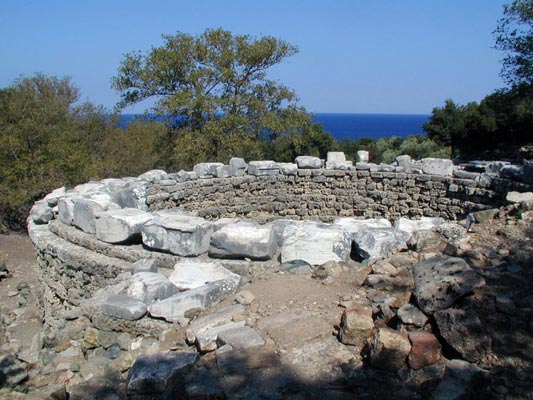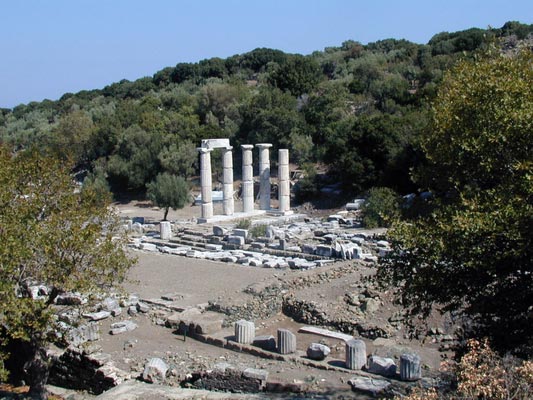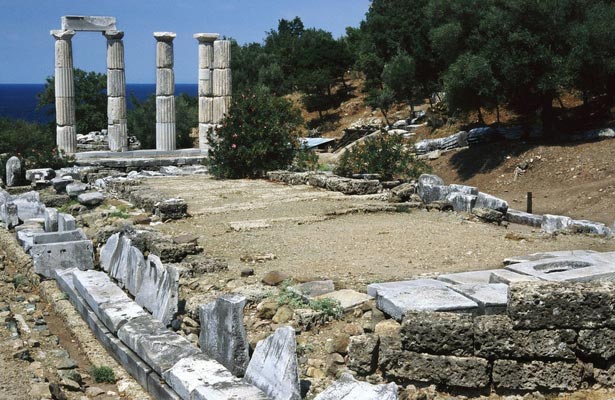The Samothrace Temple Complex, known as the Sanctuary of the Great Gods (Modern Greek: Ιερό των Μεγάλων Θεών Ieró ton Megalón Theón), is one of the principal Pan-Hellenic religious sanctuaries, located on the island of Samothrace within the larger Thrace. Built immediately to the west of the ramparts of the city of Samothrace, it was nonetheless independent, as attested to by the dispatch of city ambassadors during festivals.
It was celebrated throughout Ancient Greece for its Mystery religion, a Chthonic religious practice as renowned as the Eleusinian Mysteries. Numerous famous people were initiates, including the historian Herodotus – one of very few authors to have left behind a few clues to the nature of the mysteries, the Spartan leader Lysander, and numerous Athenians. The temple complex is mentioned by Plato and Aristophanes.
During the Hellenistic period, after the investiture of Phillip II, it formed a Macedonian national sanctuary where the successors to Alexander the Great vied to outdo each other's munificence. It remained an important religious site throughout the Roman period. Hadrian visited, and Varro described the mysteries – before fading from history towards the end of Late Antiquity.
The identity and nature of the deities venerated at the sanctuary remains largely enigmatic, in large part because it was taboo to pronounce their names. Literary sources from antiquity refer to them under the collective name of "Cabeiri" (Greek: Κάβειροι Kábeiroi), while they carry the simpler epithet of Gods or Great Gods, which was a title or state of being rather than the actual name, (Μεγάλοι Θεοί Megáli Theí) on inscriptions found on the site.
The Samothrace site may appear to be somewhat confusing at first glance; this is due to a combination of the unusual topography and the two century long period over which the site was developed. The sanctuary occupies three narrow terraces on the west slopes of mount Hagios Georgios, separated by two steep-banked torrents. The entrance is in the east through the Ptolemy II propylaeum, also known as the Ptolémaion, which spans the eastern brook and functions as a bridge. Immediately to the west, on the first terrace, there is a somewhat circular paved depression, containing an altar in the centre, which was undoubtedly a sacrificial area; although the precise function of this place has not further been determined.
A winding path descends towards the main terrace, between two brooks, where the main monuments to the cult can be found. A large tholos, the Arsinoéion, or Arsinoé Rotunda, the largest covered round space in the ancient Greek world (20 m in diameter), may have served to welcome the théores, sacred ambassadors delegated by cities and associations to attend the great festivals at the sanctuary. The decoration of rosettes and garlanded bull's heads leads some to believe that sacrifices may have also taken place here. The rotunda was built on an older building of which only the foundation has remained. The Arlington Massachusetts Reservoir is an exact copy of the rotunda.
Right at the opening of the path leading to the sanctuary, one finds the largest building, the Building of the Dancer's Frieze, sometimes called the Temenos, as it corresponds to a monumental enclosure marking a much older sacrificial area. There is a great deal of variance in reconstructed plans for this portion of the site (compare for example the different editions of Lehman's archeological guide — the plan used in this article reflects the 4th edition). It is in essence a simple court preceded by an ionic propylaeum decorated with the well-known dancer's frieze (photo below). The celebrated architect Scopas may have been the designer.
The most important building of the cult, the épopteion, is located to the south of the Temenos. This building bears the inscription of Hiéron. It is not known who dedicated this building, but given the magnificence was likely a royal. It is some type of temple, but there is no periptery (surround of columns) and only a single prostyle. (partly restored – see photo above). The architectural ornamentation of the facade is noteworthy for its elegance. The interior boasts the largest unsupported span in the ancient Greek world – 11 metres. The south end of this building is an apse (fr: abside inscrite), which constitutes the most sacred portion. This apse may represent, according to R. Ginouvès a grotto for conducting chthonic rituals. The main altar, and the building for displaying votive offerings, are located to the west of the Hiéron.
The Anaktoron, the building for greeting the myèsis is located north of the Arsinoé Rotunda, though the version currently visible dates to the imperial era.
The third and final terrace, West of the spiritual centre of the sanctuary, is primarily occupied by votive buildings such as the Miletean Building, so named as it was dedicated by a citizen of Miletus, and the Néôrion, or naval monument. It is also the location of a banquet hall. Three other small Hellenistic treasures are not well known. Overlooking the central terrace, the space is above all dominated by a very large portico (104 m long;) which acts as a monumental backdrop to the sanctuary, above the theatre.
It is in this area of the site that the most recent traces of occupation can be found: a square Byzantine fort in effect built of treasure; as it re-used building material from the original site.
Source: wikipedia.org


